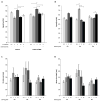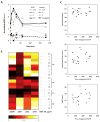Controlling multipotent stromal cell migration by integrating "course-graining" materials and "fine-tuning" small molecules via decision tree signal-response modeling
- PMID: 21782235
- PMCID: PMC3156355
- DOI: 10.1016/j.biomaterials.2011.06.050
Controlling multipotent stromal cell migration by integrating "course-graining" materials and "fine-tuning" small molecules via decision tree signal-response modeling
Abstract
Biomimetic scaffolds have been proposed as a means to facilitate tissue regeneration by multi-potent stromal cells (MSCs). Effective scaffold colonization requires a control of multiple MSC responses including survival, proliferation, differentiation, and migration. As MSC migration is relatively unstudied in this context, we present here a multi-level approach to its understanding and control, integratively tuning cell speed and directional persistence to achieve maximal mean free path (MFP) of migration. This approach employs data-driven computational modeling to ascertain small molecule drug treatments that can enhance MFP on a given materials substratum. Using poly(methyl methacrylate)-graft-poly(ethylene oxide) polymer surfaces tethered with epidermal growth factor (tEGF) and systematically adsorbed with fibronectin, vitronectin, or collagen-I to present hTERT-immortalized human MSCs with growth factor and extracellular matrix cues, we measured cell motility properties along with signaling activities of EGFR, ERK, Akt, and FAK on 19 different substrate conditions. Speed was consistent on collagen/tEGF substrates, but low associated directional persistence limited MFP. Decision tree modeling successfully predicted that ERK inhibition should enhance MFP on collagen/tEGF substrates by increasing persistence. Thus, we demonstrated a two-tiered approach to control MSC migration: materials-based "coarse-graining" complemented by small molecule "fine-tuning".
Copyright © 2011 Elsevier Ltd. All rights reserved.
Figures






Similar articles
-
Surface tethered epidermal growth factor protects proliferating and differentiating multipotential stromal cells from FasL-induced apoptosis.Stem Cells. 2013 Jan;31(1):104-16. doi: 10.1002/stem.1215. Stem Cells. 2013. PMID: 22948863 Free PMC article.
-
Sustained epidermal growth factor receptor levels and activation by tethered ligand binding enhances osteogenic differentiation of multi-potent marrow stromal cells.J Cell Physiol. 2009 Nov;221(2):306-17. doi: 10.1002/jcp.21854. J Cell Physiol. 2009. PMID: 19544388 Free PMC article.
-
In vitro mesenchymal trilineage differentiation and extracellular matrix production by adipose and bone marrow derived adult equine multipotent stromal cells on a collagen scaffold.Stem Cell Rev Rep. 2013 Dec;9(6):858-72. doi: 10.1007/s12015-013-9456-1. Stem Cell Rev Rep. 2013. PMID: 23892935 Free PMC article.
-
Epidermal growth factor (EGF) treatment on multipotential stromal cells (MSCs). Possible enhancement of therapeutic potential of MSC.J Biomed Biotechnol. 2010;2010:795385. doi: 10.1155/2010/795385. Epub 2010 Feb 17. J Biomed Biotechnol. 2010. PMID: 20182548 Free PMC article. Review.
-
Integration of Electrospun Scaffolds and Biological Polymers for Enhancing the Delivery and Efficacy of Mesenchymal Stem/Stromal Cell Therapies.Front Biosci (Landmark Ed). 2024 Jun 24;29(6):228. doi: 10.31083/j.fbl2906228. Front Biosci (Landmark Ed). 2024. PMID: 38940050 Free PMC article. Review.
Cited by
-
Tethering of Epidermal Growth Factor (EGF) to Beta Tricalcium Phosphate (βTCP) via Fusion to a High Affinity, Multimeric βTCP-Binding Peptide: Effects on Human Multipotent Stromal Cells/Connective Tissue Progenitors.PLoS One. 2015 Jun 29;10(6):e0129600. doi: 10.1371/journal.pone.0129600. eCollection 2015. PLoS One. 2015. PMID: 26121597 Free PMC article.
-
CD4+ T cell-dependent and CD4+ T cell-independent cytokine-chemokine network changes in the immune responses of HIV-infected individuals.Sci Signal. 2015 Oct 20;8(399):ra104. doi: 10.1126/scisignal.aab0808. Sci Signal. 2015. PMID: 26486173 Free PMC article.
-
Surface tethered epidermal growth factor protects proliferating and differentiating multipotential stromal cells from FasL-induced apoptosis.Stem Cells. 2013 Jan;31(1):104-16. doi: 10.1002/stem.1215. Stem Cells. 2013. PMID: 22948863 Free PMC article.
-
Envisioning migration: mathematics in both experimental analysis and modeling of cell behavior.Curr Opin Cell Biol. 2013 Oct;25(5):538-42. doi: 10.1016/j.ceb.2013.04.004. Epub 2013 May 6. Curr Opin Cell Biol. 2013. PMID: 23660413 Free PMC article. Review.
-
Tailoring chimeric ligands for studying and biasing ErbB receptor family interactions.Angew Chem Int Ed Engl. 2014 Mar 3;53(10):2662-6. doi: 10.1002/anie.201307869. Epub 2014 Jan 31. Angew Chem Int Ed Engl. 2014. PMID: 24481645 Free PMC article.
References
-
- Phinney DG, Prockop DJ. Mesenchymal stem/multipotent stromal cells: the state of transdifferentiation and modes of tissue repair-- current views. Stem Cells. 2007;25:2896–902. - PubMed
-
- Pittenger MF, Mackay AM, Beck SC, Jaiswal RK, Douglas R, Mosca JD, et al. Multilineage potential of adult human mesenchymal stem cells. Science. 1999;284:143–7. - PubMed
Publication types
MeSH terms
Substances
Grants and funding
LinkOut - more resources
Full Text Sources
Research Materials
Miscellaneous

